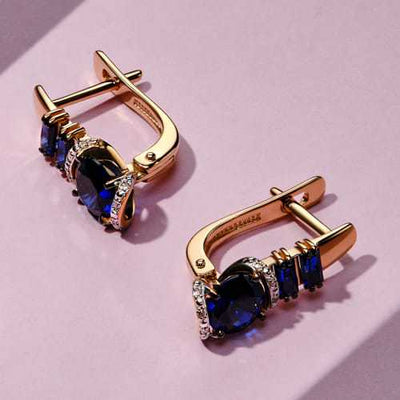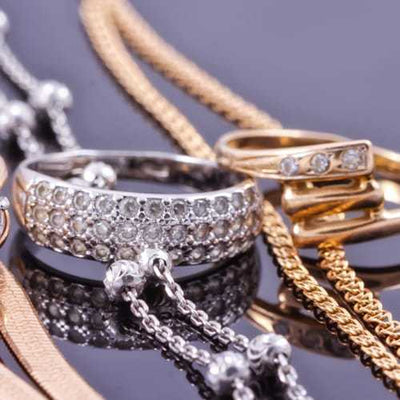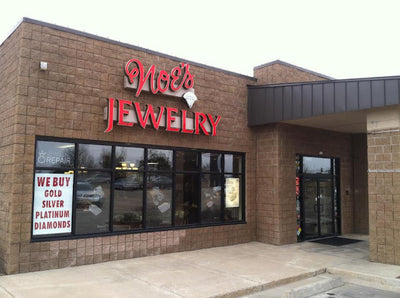What Is Topaz?
Topaz is a rare silicate mineral that generally forms in fractures and cavities of igneous rocks like pegmatite and rhyolite. This mineral can also be found as water-worn pebbles in stream sediments.
This unique gemstone can be found in a variety of different colors including, yellow, brown, orange, red, pink, purple-red, blue, light green, and colorless. As an allochromatic gem, the color of each individual topaz stone is caused by impurity elements or defects in the crystal structure rather than an element of the stones’ basic chemical composition. For example, brown, yellow, and blue topaz stones are caused by imperfections at the atomic level of the gem’s crystal structure. Pink, red, and purple topaz are caused by the element chromium. Additionally, topaz is pleochroic, which means that the stones can show different colors in different crystal directions.
Topaz crystals are generally elongated. They also have grooves parallel to the length of the crystals. Due to the natural shape of these gems, they are often cut into long oval or pear shapes.
Topaz is actually used for two different birthstones. Precious topaz is the orange-colored birthstone representing November, while blue topaz is the birthstone for December.
Types of Topaz
Most “types” of topaz are just referred to by their color (e.g., blue topaz or pink topaz). However, there are types that are given special names.
- Imperial topaz: Medium reddish-orange to orange-red in color; it is one of the most expensive types of topaz.
- Sherry topaz: Yellowish-brown or brownish-yellow to orange color; its name is derived from sherry wine, which is a similar color.
- Azotic topaz: Orange-pink topaz with a rainbow color effect; this color is caused by a film deposition of a very thin metallic layer placed over the top of the gemstone.
- London blue topaz: Deep sky-blue topaz that is darker than Swiss blue topaz.
- Swiss blue topaz: A sky-blue colored topaz that is lighter than London blue topaz.
- Mystic topaz: Multicolored topaz with a rainbow-like effect; the color is also caused by a thin metallic layer being placed over the stone.
- Rutilated topaz: Topaz containing yellow needle-like inclusions of Limonite.
- Silver topaz: colorless topaz, also called white topaz.
Where is Topaz Found?
The largest Topaz producing country in the world in Brazil. However, topaz can also be found in Pakistan, Afghanistan, India, China, Sri Lanka, Russia, Japan, Australia, Madagascar, Mexico, and the United States. In the United States, topaz has been mined in Utah, California, and New Hampshire.
4 C’s for Topaz
Just like with diamonds, there are guidelines in place for grading the quality of topaz gems. The 4 C’s are the same for grading these gems.Color
The color of topaz varies greatly. However, the most valuable topaz colors are orange-red to red. This is because less than one-half of one percent of all topaz gemstones are red. For this reason, imperial topaz is highly sought after.
Pink topaz, often called rose topaz, looks similar to a pink diamond or sapphire. Since it is less expensive than a pink diamond and often available in larger sizes than both pink diamonds and sapphires, it can be advantageous to use pink topaz in jewelry.
Naturally blue topaz is rare, but most topaz is actually colorless. Treatments can create the strong blue hues we are used to. For this reason, there are a lot of blue topaz gemstones, so stones in this color range tend to be less valuable.
Some topaz specimens are bicolored. These unique gems are used in fashion jewelry pieces.
Clarity
Topaz used in jewelry will usually have no visible inclusions. This is especially true for topaz that is colorless, blue, and yellow. In some cases, less pure stones will be used in jewelry.Cut
Since topaz crystals are generally long and slender, they can be cut in shapes that yield the most value. These shapes would be oval or pear shapes, but they can also come in round and other shapes. Emerald cuts are common in topaz that is strongly colored because this cut maximizes the color and retains a higher carat weight.Carat Weight
Due to the large size of many topaz crystals, gemstones can often be quite large, but usually, one crystal is cut into more than one gemstone. There is a wide range of topaz sizes available, and smaller gems are relatively inexpensive. Once gems exceed 10mm by 8 mm, prices start to increase.Caring for Topaz
You want to keep your topaz gemstones looking their very best. This means that you need to care for topaz properly. While topaz rates an eight on the Mohs hardness scale, it requires gentle cleaning. You should avoid steam or ultrasound cleanings. Instead, opt for warm, soapy water when you clean your topaz jewelry.
You will also want to avoid sudden temperature changes with your topaz.
To see a wide variety of topaz jewelry, stop into Noe’s Jewelry in Raymore, Missouri. Our expert jewelers can help you find the perfect topaz piece to add to your jewelry collection.
Check out the other stones in our Gemstone Series Guides:





